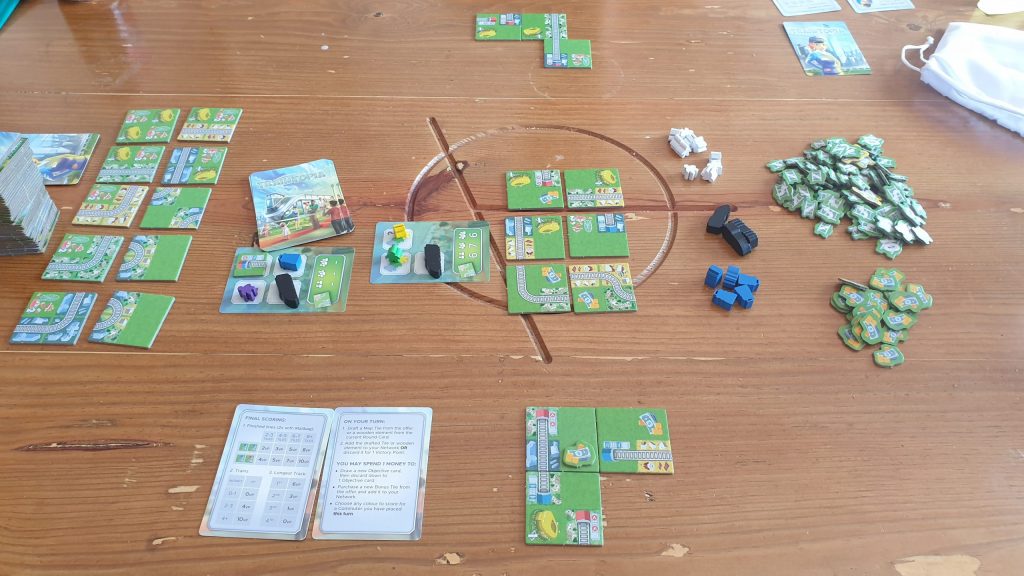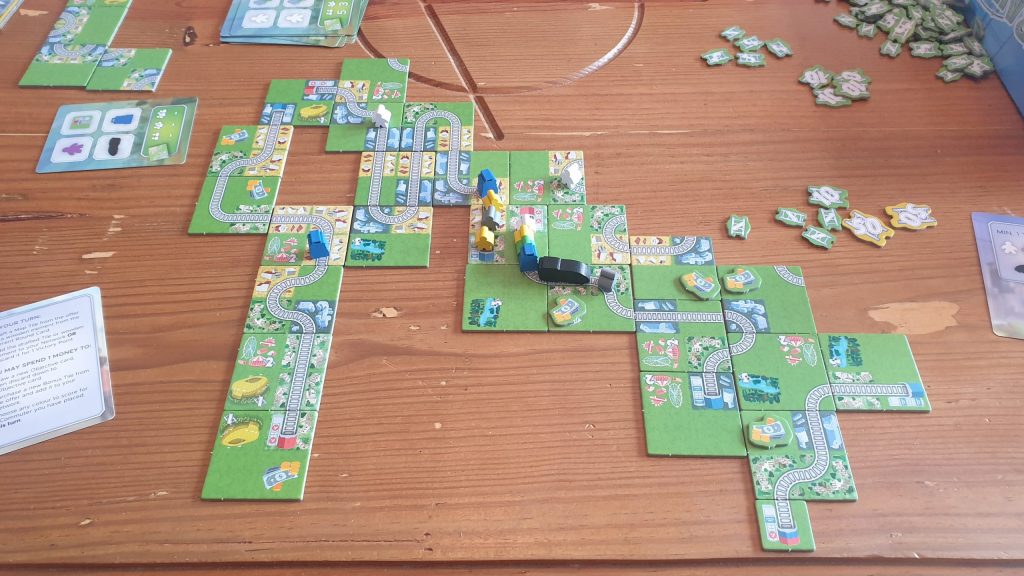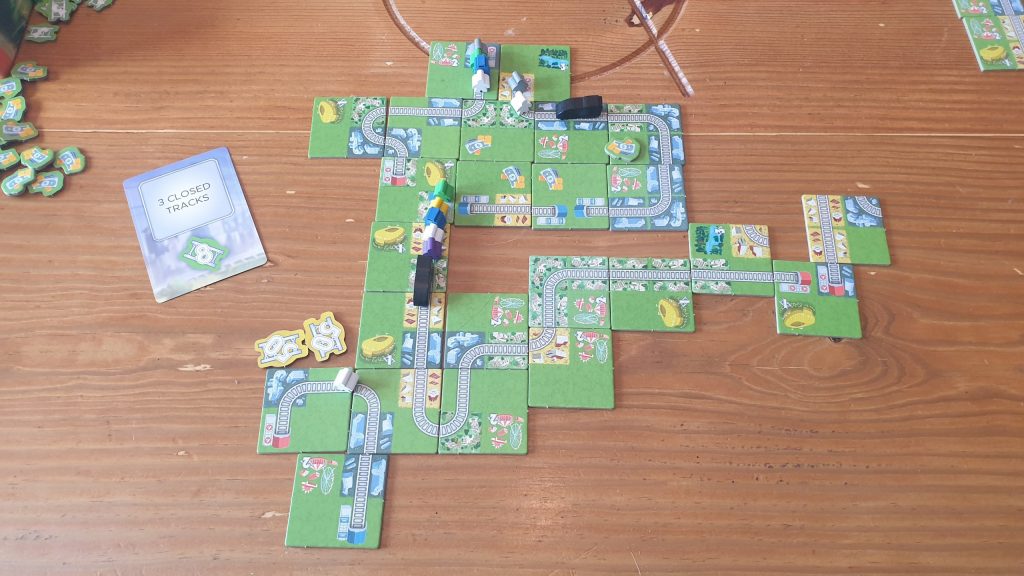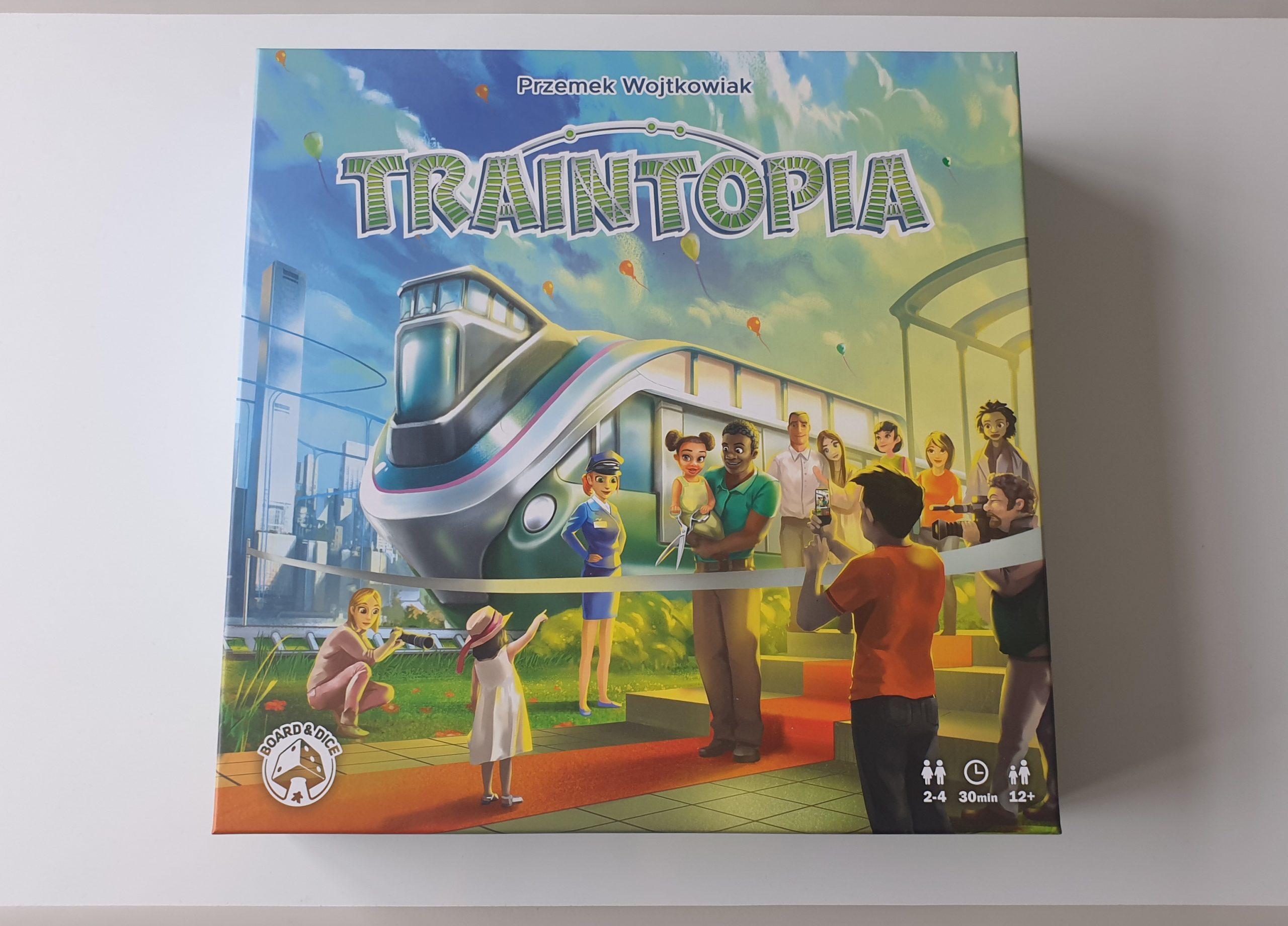Traintopia is the brand new railroad themed drafting and tile placement board game from publisher Board & Dice. Designed by Przemek Wojtkowiak, featuring artwork from Jakub Fajtanowski and Zbigniew Umgelter, the game plays in around 30 minutes with 2 – 4 players. Players will be claiming mailbags, trains, commuters and building out railroad networks – all in a venture for point! However, is the game on the right track? Let’s find out!
After setup each player will have a starting tile with 2 snake drafted tiles placed adjacent to it and a personal objective. From here on there will be 8/9 rounds, depending on the player count, before a bonus round ends the game. The normal rounds see players drafting either tiles or wooden elements, and choosing to play them or discard them to the box. An example round would see 5 tiles drawn from the stack, a mailbag, a couple of commuters randomly drawn from a bag and a single tourist meeple.
Taking it in turns, going clockwise from the starting player, players choose one of the items available – until one item remains which is discarded. Drafted tiles are instantly played adjacent to existing tiles in your own network, while drafted wooden elements are instantly placed onto your railroad tracks. The hook that sets Traintopia apart from other tile placement games is that each tile is split into four and that only half of an edge needs to be adjacent to a previously placed tile. As well as making placing tiles a little more forgiving, it results in players’ personal networks sprawling further across the table.

Elements on the tiles can be tracks, red or blue stations, coloured zones that match the 3 commuter colours, 1 – 3 numbered attractions, money symbols and the occasional empty field. The colours of the zones being passed over don’t impact placement but they do lead to point scoring opportunities, as do the attractions and the money symbols. Each railroad can have a commuter of each colour, 1 tourist, 1 train and 1 mailbag on it. When placed commuters score points based on the squares of matching colour that the railroad passes over. Tourists are placed in the same way but instead score points equal to the sum of the attraction values a railroad passes adjacent to.
While Trains and mailbags are instantly placed they only score at the end of the game. Money symbols are instantly covered by a money token, and these give the player new opportunities. Spending a money token at any point on your turn lets you treat a commuter as a wild coloured commuter to score any colour you wish or obtain one of the available bonus tiles – of which there is always the same selection of 10 tiles.
Play continues with players building out their networks and adding commuters and more to their railroads. After the final normal round a bonus round sees a final train, mailbag, wild coloured commuter and a special 1 square station drafted. Completed railroads, with a station at each end, then score based on their length. These are worth more points if the two stations have different coloured roofs and the points are doubled if the railroad has a mailbag on it. Points are then scores based on the money token that weren’t spent that are adjacent to railroads with trains on them, before whomever has the longest railroad gets 6 points. Finally, players check to see if they achieved their personal objectives, such as having a railroad with every wooden element on it, before whomever has the most points is crowned the winner.

Traintopia’s biggest issue is that there isn’t much variety between games. The personal objective cards are a small driver of difference. Unfortunately, for half you can easily complete them and then forget about them. They also represent such a tiny fraction of the end scores they may as well be forgotten. In a 2 player game scores of 100+ aren’t rare with only 5 – 10 points earnt by personal objectives – often the equivalent of placing a single commuter meeple. One benefit is that these secret goals don’t swing the game, potentially only slightly tipping the balance, yet they are still lackluster.
Making each game feel more alike is that the Train method of scoring, via unspent money tokens, seems “pointless”. Often towards the end of a game spending a single money token can allow players to perform an action that nets them comfortably 7 or 8 points. Therefore the points earnt for trains going past unspent tokens is simply not enough. Therefore, any strategy that could have been formed around not spending money tokens becomes counterproductive.
Enhancing the want to spend the money tokens is the fact they are one of the most exciting elements of the game. They allow players to slightly bend the rules to score a ton of points or obtain an extra tile, for a bigger than usual turn. Despite a whole pile of money tokens there aren’t many tiles that feature the money symbol, so when players do get them they do feel special. However, if all players started with a money token it could perhaps kickstart the game a little more, and give the option of holding onto it for later or spending it early.

From a production standpoint the components of the game are solid. Solid but not eye catching. The choice was clearly made to go with a design that emphasises readability. It is always extremely easy to see the difference between the different coloured zones for example, and the fact the attractions are actually numbered. While everything is clear it leaves Traintopia with an uninspiring appearance, with the best artwork being the box cover.
Combining two of my favourite mechanics in the form of drafting and tile placement I had high hopes for Traintopia. Alas, whilst being a solid experience and a relatively fun game it is lacking that spark. The personal objectives are a forgettable aspect of the experience and the money tokens aren’t free flowing enough to save the day. With a lack of different scoring routes it means players aim to do the same thing each time, and this is ultimately why it fell flat for me. However, for those that don’t enjoy high levels of player interaction it is only really there in the drafting stage, with everyone building their own separate networks. Also, there are often a lot of points earnt both during and after the end of the game, so players do feel a steady sense of achievement while playing. So, Traintopia might not be one for my gaming shelf but it could be for yours.
(Editor’s Note: Traintopia was provided to us by Asmodee for the review. The game is currently available from local board game stores, some of which are reopening! Find your local store here.)

